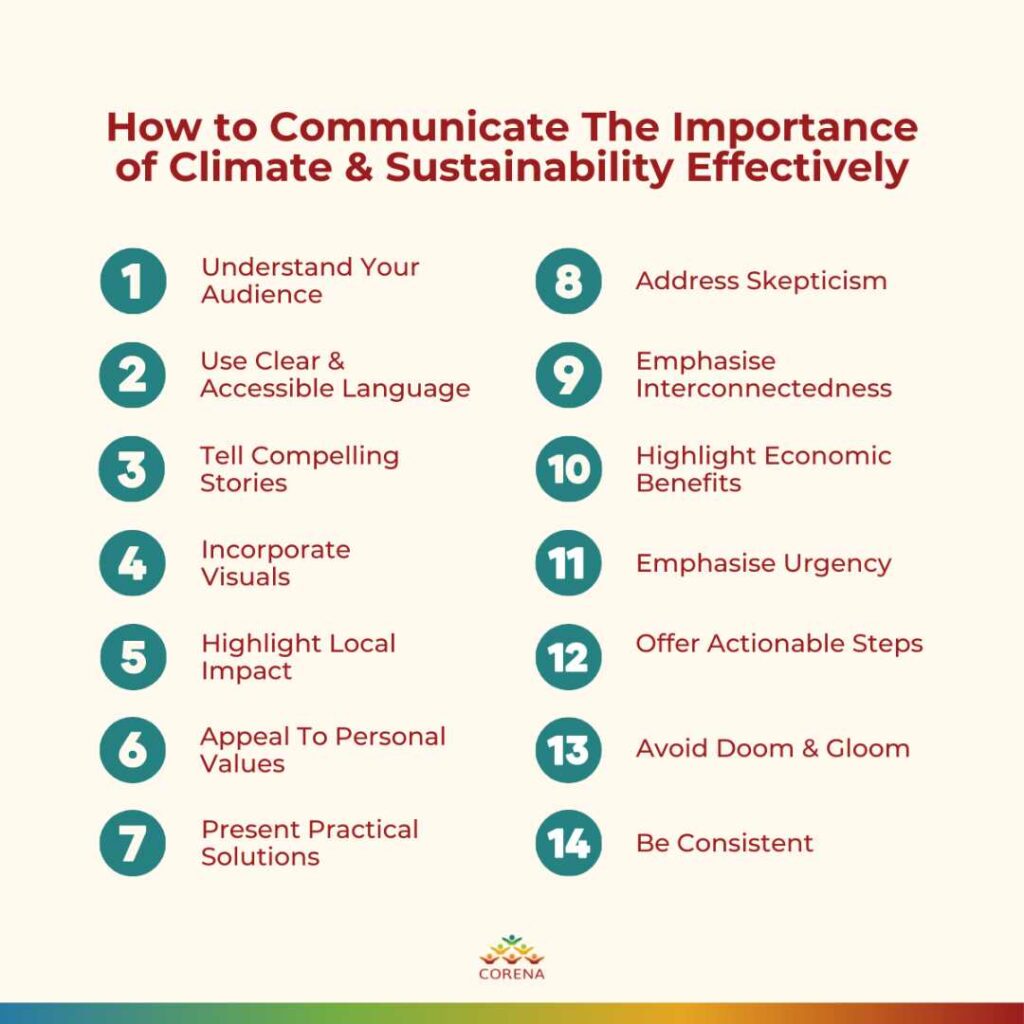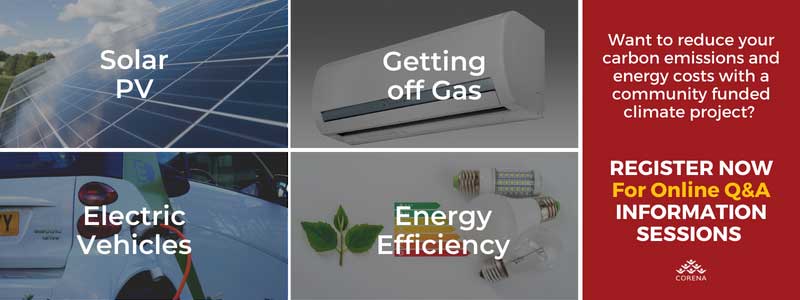In a world facing a climate emergency, it is more important than ever to educate those around us of the importance of climate action. Whether in your community, workplace, or socially, communicating and emphasising the importance of taking positive actions such as embracing energy efficiency, getting off gas, transitioning to renewable energy sources and switching to all electric appliances and vehicles, can help ensure we collectively achieve a lower carbon footprint and remain under 1.5C of warming.
CORENA works with a wide range of non profits, charities, social enterprises and community organisations. We provide free technical advice, as well as interest-free loans to fund community projects that reduce carbon emissions and energy costs.
Every job is a climate job. If you work for a non profit, in any capacity, we need champions like you to influence your organisation to reduce their carbon emissions. If you don’t work for a non-profit, how can you convince your own workplace, local school or community centre to take action. We’ve put together this guide on how you can raise awareness and encourage people to take climate action through communicating the importance of climate and sustainability.

14 Tips To Communicate Climate & Sustainability More Effectively
1. Understand Your Audience
Whether you’re speaking to your boss, students, businesses, or the general public, it is critical to tailor your message to their specific interests, values and concerns. Knowing your target audience is the first step towards deciding exactly what you are going to communicate, and how, for the best results. Take the time to understand your audience’s unique perspective so you can craft relevant messages that have an impact. For example, if you work in a non profit, who manages your buildings and maintenance? They are the ones who may have the influence to install solar panels or undertake an energy audit. Before asking them about solar panels be prepared to answer questions about ongoing costs, savings and maintenance. CORENA is happy to help out with this information if you need it.
2. Use Clear & Accessible Language
When communicating the importance of climate change and sustainability, avoid jargon and overly technical terms. People are put off by such language and may stop listening. Use simple and relatable language to ensure the message is understood by the widest range of people possible.
3. Tell Compelling Stories
While statistics and figures are impactful, compelling stories made up of personal anecdotes and real-life examples are more engaging and relatable. People connect more deeply with narratives and compelling stories than with cold statistics. A great example is this video by Believe Housing about Project 50. which features a short interview with one of their tenants.
4. Incorporate Visuals
Compelling stories are effective, but their impact multiplies when combined with well-thought-out visuals. It is really true that a picture tells 1000 words! This could include photographs, videos, charts and infographics that present statistical information in a visually appealing and easily digestible format. Visuals cross language barriers and simplify complicated concepts for a lasting impact.
5. Highlight Local Impact
Emphasise how climate change directly affects local communities. Showing the relevance of climate change and sustainability issues to people’s daily lives and immediate environment will make them more likely to pay attention and take action. If you can show how such a global issue can hit home on a personal level, the message will have a more profound effect on them.
6. Appeal To Personal Values
Frame your message around the values that your audience resonates with. Research these values in relation to your target audience, which might include health, economic stability, social justice, or the well-being of their children. Aligning your message with your audience’s key values makes it more powerful.
7. Present Practical Solutions
It is important to share the problem we all collectively face with the impacts of the climate crisis worsening, but we also need to share practical solutions that individuals, communities, or businesses can adopt to feel empowered to take action. Highlight success stories and best practices that inspire others to feel a part of a solution. If audiences know how they can help and see examples of it working, they will be more inclined to take the message to heart and actually do something. Donating to a CORENA project or encouraging an organisation to apply for a loan is one such practical solution.
8. Address Skepticism
There are persistent myths about a range of renewable technologies that are often outdated and incorrect. Engage with skeptics by providing calm, rational, evidence-based rebuttals using credible sources and clear explanations. Building trust is key. It never pays to shut naysayers down, as silencing opposition erodes trust. Rather, seek to engage and understand before being understood. For electric vehicle myth busting the Electric Vehicle Council is a great source of information, as is the SolarQuotes blogs for solar panel questions. Or you can ask CORENA, we have heard all the arguments before and can point you in the direction of credible resources.
9. Emphasise Interconnectedness
Connect climate change to other aspects of life, such as energy use, consumption, food production, water availability, health and the economy. Illustrate how positive or negative impacts on one factor affect others. Nothing operates in isolation. Amongst many other benefits – climate projects in non profits usually have the added benefits of resilience to energy price increases. Solar panels can give vulnerable tenants the ability to run their air conditioning during ever increasing heat waves which has huge health benefits. Batteries can assist in power outages and electric vehicles with vehicle to load functions can provide emergency power supplies.
10. Highlight Economic Benefits
Communicate how sustainable practices can save costs and create new jobs, achieving long-term economic stability. Demonstrating economic advantages makes the message more attractive and garners greater support. In most cases it is relatively simple to calculate how much your project will save over its lifetime and we are happy to help you crunch the numbers. For smaller solar projects Solar Quotes has a great solar calculator.
11. Emphasise Urgency
Convey the time-sensitive nature of climate change by sharing data on current trends and the potential consequences of inaction. Make sure the target audience understands the finite window for effective action and the consequences of delaying action for too long. The Climate Council website is an excellent source of up to date and accessible information about the climate emergency.
12. Offer Actionable Steps
Provide specific, achievable actions for individuals, organisations, or communities to contribute to a greener planet. Every person’s involvement is essential. However, they need to know what they should do. Communicating practical steps that each person can take encourages participation. In your workplace a simple climate action plan is a great way to do this. You can read more about developing a climate action plan here – How To Create A Net Zero Action Plan & Become Carbon Neutral: A Guide For Non Profits
13. Avoid Doom & Gloom
Balance alarming information about climate change with messages of hope and progress so as not to overwhelm them with panic and anxiety. This can lead to paralysis. Positive messages tend to resonate better and yield better results, while excessive negativity can lead to despair.
14. Be Consistent
People need to hear a message at least 7 times before they take action. Consistent messaging builds trust and sustains audience engagement. Regular updates and the reinforcement of messages can help maintain credibility and keep the issue relevant. Stay on message and provide a consistent drip feed of information to keep interest piqued. Sometimes hearing the same message from different sources can help. If you think it would help to have CORENA present via Zoom directly to your board or decision makers we are happy to do so!
Interest Free Loans For Energy Efficiency, Solar Panels, Electric Vehicles & Other Projects To Reduce Carbon Emissions & Save On Energy Costs
CORENA is funded by donations from local community members across Australia. Donations help us to provide funding to non profit and community organisations for:
- Solar Panels
- Energy Efficiency – such as switching to efficient alternatives or installing insulation
- Getting Off Gas – Replacement of fossil gas appliances with electric alternatives
- Electric Vehicles
- A combination of the above
No interest is paid on CORENA loans, and the quarterly loan repayments are set to be a little less than the savings on operating costs averaged over a year. After the loan is fully repaid, loan recipients reap the full financial benefit of having lower operating costs.
Learn more in 5 Ways CORENA Helps Non Profits Reduce Carbon Emissions & Energy Costs
If you work for a non profit or would like to convince a non profit in your community to apply for a loan, we have a range of resources on the “Help or Join” section of our website. This includes a pdf info page, checklist for prospective loan recipients, social media resources and template newsletter text.
To learn more, check out how to apply for a loan, or register for one of our upcoming Online Q&A Information Sessions.


